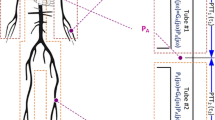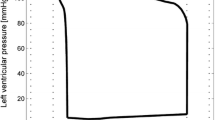Abstract
A cardiovascular parameter estimator to identify the systemic vascular parameters was developed using an extended Kalman filter (EKF) algorithm. Measurements from a ventricular assist device (VAD) and arterial pressure were used in the estimator. The systemic vascular parameters are important indices of heart condition. However, obtaining these parameters usually requires invasive measurements, which are difficult to obtain under most clinical environments. Including a VAD model into the estimator and using the signals from a VAD to identify the cardiovascular parameters for VAD patients would minimize the need for indwelling sensors. This paper illustrates the use of a Novacor left ventricular assist system (LVAS) model with a cardiovascular model in the estimator to identify the systemic vascular parameters: characteristic resistance, blood inertance at the aorta, systemic compliance, and systemic resistance. Performance of the estimator was evaluated using data from a computer simulation and from a mock circulatory system experiment. Robustness of the estimator to the available measurements was also described. The estimation results showed that the estimates converged with reasonable accuracy in a limited time when the LVAS pump volume and arterial pressure were used as measurements. These parameter estimates can provide additional diagnostic information for patient and device monitoring and can be used for future VAD control development. © 2001 Biomedical Engineering Society.
PAC01: 8719Uv, 8719Hh
Similar content being viewed by others
References
Avanzolini, G., P. Barbini, and A. Cappello. Comparison of algorithms for tracking short-term changes in arterial circulation parameters. IEEE Trans. Biomed. Eng.39:861–867, 1992.
Chang, P. P., G. L. Matson, J. E. Kendrick, and V. C. Rideout. Parameter estimation in canine cardiovascular system. IEEE Trans. Autom. Control19:927–931, 1973.
Clark, J. W., R. L. S. Ling, R. Srinivasan, J. S. Cole, and R. C. Pruett. A two-stage identification scheme for the determination of the parameters of a model of left heart and systemic circulation. IEEE Trans. Biomed. Eng.27:20–29, 1980.
Deswysen, B.Parameter estimation of a simple model of the left ventricle and of the systemic vascular bed, with particular attention to the physical meaning of the left ventricle parameters. IEEE Trans. Biomed. Eng.24:29–36, 1977.
Deswysen, B., A. A. Charlier, and M. Gevers. Quantitative evaluation of the systemic arterial bed by parameter estimation of a simple model. Med. Biol. Eng. Comput.18:153–166, 1980.
Frazier, O. H., and T. J. Myers. Left ventricular assist systems as a bridge to myocardial recovery. Ann. Thorac. Surg.68:734–741, 1999.
Gelb, A. Applied Optimal Estimation. Cambridge, MA: M.I.T. Press, 1974.
Graen, M. D., D. L. Ewert, J. S. Glower, L. A. Gray, and S. C. Koenig. Can a linear electrical analog model of a mechanical valve predict flow by using a pressure gradient?ASAIO J.46:563–568, 2000.
LaForge, D. H., and P. M. Portner. Self-sufficient instantaneous hemodynamic control of an intrathoracic cardiac assist system, Proceedings of 29th Annual Conference Engineering Medical Biology, 1976, p. 237.
Marble, A. E., C. M. McIntyre, R. Hastings-James, and C. W. Hor. A comparison of digital algorithms used in computing the derivative of left ventricular pressure. IEEE Trans. Biomed. Eng.28:524–529, 1981.
McInnis, B. C., Z.-W. Guo, P. C. Lu, and J.-C. Wang. Adaptive control of left ventricular bypass assist devices. IEEE Trans. Autom. Control30:322–329, 1985.
More, J. J. The Levenburg-Marquardt algorithm: Implementation and theory. In: Numerical Analysis, Lecture Notes in Mathematics 630, edited by G. A. Watson. New York: Springer, pp. 269–312.
Nichols, W. W., C. R. Conti, W. E. Walker, and W. R. Milnor. Input impedance of the systemic circulation in man. Circ. Res.40:451–458, 1977.
Portner, P. M., P. E. Oyer, J. S. Jassawalla, H. Chen, P. J. Miller, D. H. LaForge, G. F. Green, and N. E. Shumway. A totally implantable ventricular assist device for end-stage heart disease. In: Assisted Circulation 2, edited by F. Unger. New York: Springer, 1984, pp. 115–141.
Ruchti, T. L., R. H. Brown, D. C. Jeutter, and X. Feng. Identification algorithm for systemic arterial parameters with application to total artificial heart control. Ann. Biomed. Eng.21:221–236, 1993.
Shimooka, T., Y. Mitamura, and T. Yuhta. Investigation of parameter estimator and adaptive controller for assist pump by computer simulation. Artif. Organs15:119–128, 1991.
Siouris, G. M. An Engineering Approach to Optimal Control and Estimation Theory. New York: Wiley, 1996, p. 139.
Stephan, J., M. Bodson, and J. Chiasson. Real-time estimation of the parameters, and fluxes of induction motors. IEEE Trans. Ind. Appl.30:746–758, 1994.
Suga, H., K. Sagawa, and L. Demer. Determinants of instantaneous pressure in canine left ventricle, time and volume specification. Circ. Res.46:256–263, 1980.
Toy, S. M., J. Melbin, and A. Noordergraaf. Reduced models of arterial systems. IEEE Trans. Biomed. Eng.32:174–176, 1985.
Yamakoshi, K., A. Kamiya, H. Shimazu, H. Ito, and T. Togawa. Noninvasive automatic monitoring of instaneous arterial pressure using the vascular unloading technique. Med. Biol. Eng. Comput.21:557–565, 1983.
Yu, Y.-C., J. R. Boston, M. A. Simaan, and J. F. Antaki. Estimation of systemic vascular bed parameters for artificial heart control. IEEE Trans. Autom. Control43:765–778, 1998.
Yu, Y.-C. Minimally invasive estimation of cardiovascular parameters. Ph.D. thesis, University of Pittsburgh, 1998.
Yu, Y.-C., J. R. Boston, M. A. Simaan, P. J. Miller, and J. F. Antaki. Modeling and simulation of a blood pump for the development of a left ventricular assist system controller. Kybernetika35:651–664, 1999.
Author information
Authors and Affiliations
Rights and permissions
About this article
Cite this article
Yu, YC., Boston, J.R., Simaan, M.A. et al. Minimally Invasive Estimation of Systemic Vascular Parameters. Annals of Biomedical Engineering 29, 595–606 (2001). https://doi.org/10.1114/1.1380420
Issue Date:
DOI: https://doi.org/10.1114/1.1380420




